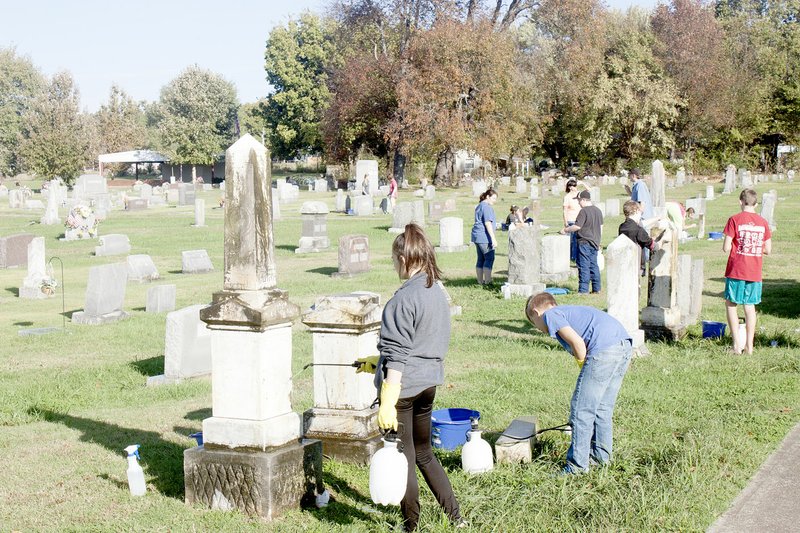PRAIRIE GROVE -- Summer Rickert, a seventh-grader at Prairie Grove Middle School, was cleaning an old gravestone at Prairie Grove Cemetery when a friend noticed the deceased had the same last name as Summer.
Summer soon realized she was related to the people buried next to each other in the cemetery: Henry Rickert, 1840-1895, and his wife, Jennie Rickert, 1851-1905. Both headstones called each other, "Dearest one."
Her next step, Summer said, will be to research the couple and find out more about her relatives.
Rickert and about 15 middle school students recently spent most of the day cleaning tombstones at Prairie Grove Cemetery as part of a project sponsored by the school's EAST classes. EAST stands for Environmental and Spatial Technology and is a national initiative that focuses on student-driven service projects.
Tracie Ashley, EAST facilitator, said the program's focus this year is to stay local and seek out new community partners.
Susan Parks-Spencer, a Prairie Grove resident who is a member of the Washington County Historical Society, sparked the students' interest in helping out at the cemetery, Ashley said. The historical society's board held a meeting in the EAST classroom and this "got the ball rolling."
Summer's story of finding the gravestone of relatives is what Ashley hopes will happen with the partnership.
"We're bringing up family history and bringing up stories," she said.
Students started their morning with instructions from Bob Young with Washington County Cemetery Preservation Group on how to properly clean gravestones.
Washington County has 350 cemeteries, Young said. Many are small cemeteries, located in rural areas in the corner of the family farm. The farm is sold. Cattle will come through and rub against gravestones and knock over the monuments. Older gravestones are called tablets and lay flat on the ground. Eventually, the cemetery becomes overgrown and is "lost to time," Young said.
The preservation group is available to work with anyone to help save and preserve those cemeteries in the county.
The first step in cleaning a monument, Young said, is to make sure the gravestone is secure. If it is, students were told to rinse the stone with water and use a plastic or wood scraper to remove any biologicals accumulated on the surface. Rinse again and then students sprayed the gravestones with a cleaner called D/2 Biological Solution. Almost immediately, students could see a difference in the monument.
They were told to let the solution soak in five-10 minutes and then they could go back and scrub with a plastic bristle brush to further clean the tombstone, if necessary.
Other products are available but the preservation group uses D/2 because it is the superior solution, Young said. The same solution is used on the White House and the Acropolis in Athens, Greece.
The best part of using the solution, Young said, is that participants can see what they've accomplished before they leave for the day.
"You get the gratification of seeing it," Young added.
Parks-Spencer also was on hand cleaning gravestones that day and she said she was impressed by the students' enthusiasm.
Cheryl West with Prairie Grove Cemetery Association said the association was thrilled the students wanted to clean gravestones in the cemetery and help preserve the history of the burial sites.
Prairie Grove Cemetery dates back to 1831. It includes a section that has been named to the National Register of Historic Places as well as other areas that have been added over the years.
Eventually, Ashley said, the students want to clean the gravestones in the historic section of the cemetery. Other ideas are to produce an online interactive map of the cemetery with photos of gravestones matching information about the deceased. Another possibility is to install QR codes in the cemetery so visitors can scan the QR code using their smartphone to find out more information about the cemetery and people who are buried there.
"I see the potential for this to get bigger and bigger," said Ashley.
General News on 11/23/2016
